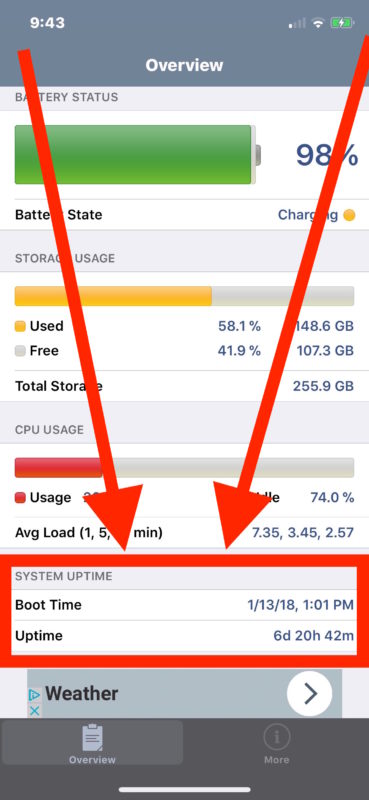How to Check Uptime of iPhone or iPad to See When Last Booted

Uptime determines how long a computer or iOS device has been turned on for, or at least when the hardware was last booted or rebooted. On a unix machine or any Mac, you can check uptime with the uptime command or system System Information, but the iPhone and iPad has no such mechanism for seeing uptime by default. Fortunately there are a few third party apps available which can reveal device uptime in iOS, so if you want to know when an iPhone or iPad was last turned on or rebooted, you can uncover that information with the help of such an application.
We’ll cover two simple options to retrieve uptime information from an iPhone or iPad, so that you can see when the iOS device last went through a boot sequence.
Get iPhone or iPad Uptime with System Status Lite for iOS
One option to get iOS device uptime is to use the free System Status Lite app for iPhone or iPad. This app is arguably a bit easier to use than the other option since you don’t need to run any commands to see the last time the device was rebooted or turned on along with uptime.
- Get System Status Lite for iOS here and launch the app
- Look for “System Uptime” near the bottom of the System Status app to find “Uptime” and “Boot Time” with the date and time of last boot, as well as the device uptime

In this screenshot example, an iPhone was last booted (rebooted) 6 days and 20 hours ago, and the app also shows the exact date and time the device last booted up.
Get iOS Device Uptime with OpenTerm Command Line
iOS may not yet have an official Terminal app, but an excellent unofficial choice is the OpenTerm command line app for iOS (it used to be called Terminal but the developer had to change the name). OpenTerm is a free sandboxed command line interface for iPhone and iPad that allows you to play around with various command line tools and commands with little risk consequence since the app is completely sandboxed. OpenTerm also allows you to run the same old uptime command that works on Mac and unix machines.
- Get OpenTerm for iOS here then launch the app when it is finished downloading
- Type “uptime” and hit Return on the iOS keyboard to see uptime details for the iPhone or iPad, looking something like the following:
iPad: uptime
9:55 up 11 days, 44 mins, 0 users, load averages: 2.43 2.81 3.20

In this screenshot example, an iPad has been up for over 11 days, meaning the device was last turned on from a powered off state or rebooted 11 days ago.
Why should I care about device uptime?
You probably shouldn’t. But, knowing the precise uptime of any computer or device can be helpful for troubleshooting, or even for digital forensic purposes. Admittedly that makes this largely irrelevant to most casual iPhone and iPad users, but it can still be interesting information for some people to know, even if they don’t find it particularly actionable.
Additionally, there’s an element of somewhat goofy nerd pride with having an extended uptime, because a lengthy uptime can be indicative of a stable operating system environment or workstation (or just indicative of a machine that sits idle with no use, but that’s not where the nerd cred is). This is largely from nerdier unix days, but many of us geekier folks continue to find this to be a fun measurement of any computer, whether it’s in the palm of your hand, on your lap, a desk, or in some server room somewhere.
So there you have it, now you know how you can check iOS device uptime and the last time an iPhone or iPad was booted. If you know of another good way to discover this information, share it with us in the comments below!


It’s much easier. Just scroll to the bottom of the cellular page on iphone settings. It will say “Last Reset: Mon D, Year at time”.
Interesting post! Thank you so much!!!